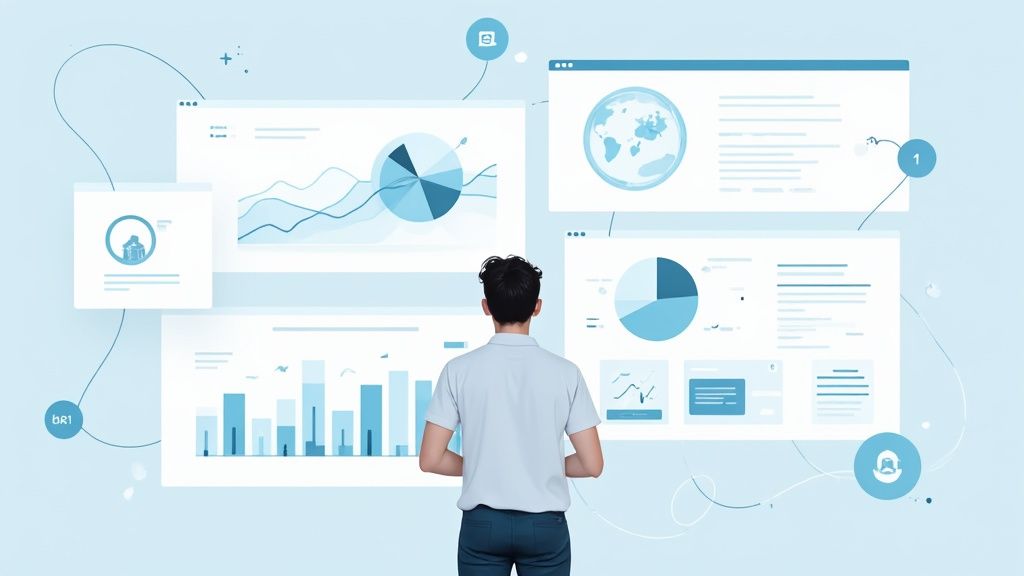
How to Land High-Paying Sports Analytics Jobs
So, you're thinking about a career in sports analytics? Smart move. You’re looking at a field that's absolutely blowing up with opportunities. The days of front offices running on gut feelings and old-school scouting reports are fading fast. Today, data is king, influencing every major decision, from who gets drafted to how a team sets its defensive plays.
The Reality of a Career in Sports Analytics
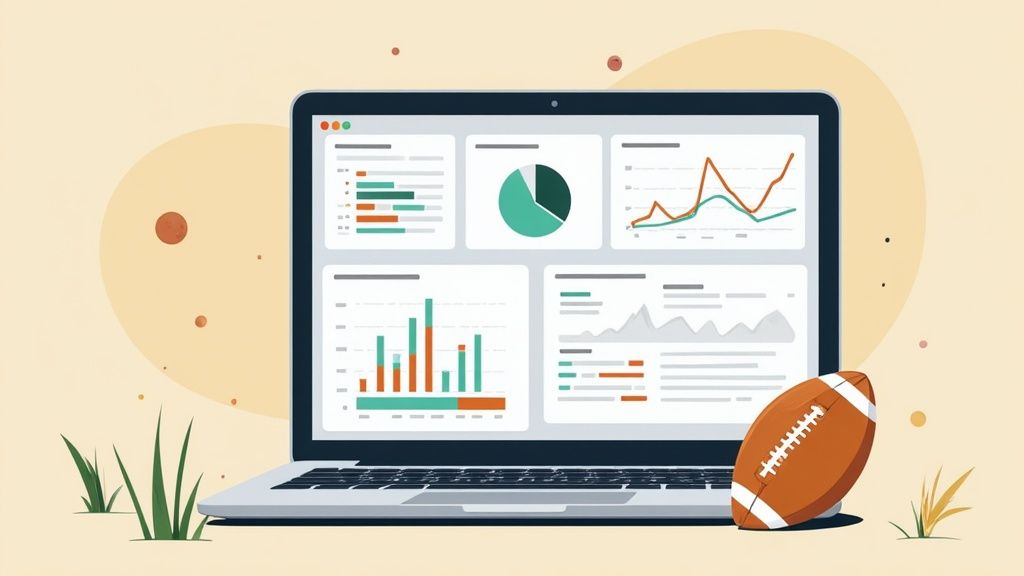
This is a fundamental change in how the entire sports industry works. The growth numbers are staggering. The global sports analytics market is projected to explode to over $26.31 billion by 2032, up from an estimated $4.75 billion in 2024.
What’s driving this? Teams are hungry for any edge they can get, and they’re finding it by adopting advanced techniques like machine learning, player-tracking systems, and sophisticated video analysis. If you want to dive deeper into the numbers, you can explore the full market forecast from Consegiç Business Intelligence to see just how big this wave is getting.
So, What Does a Sports Analyst Actually Do?
At its heart, a sports analyst's job is to hunt for meaningful patterns in a sea of data. Your day-to-day involves getting your hands dirty cleaning massive datasets, building statistical models to predict outcomes, and, crucially, creating clear visuals that tell a story. You have to communicate your findings to coaches and executives who might not be data geeks themselves.
The work you do has a real, tangible impact on the field. An insight you uncover could completely reshape a team's draft strategy, spark a new in-game tactic, or even help predict and prevent player injuries. It’s a role that demands a unique blend of sharp technical skills and a deep, intuitive understanding of the sport.
The sports analytics world is also full of different roles, each with its own focus. Here’s a quick look at some of the common job titles you'll come across. If you're wondering which role fits you best, checking out real-world job descriptions on www.sportsjobs.online can provide great clarity.
Key Roles in the Sports Analytics Field
Here is a breakdown of common job titles in sports analytics, what they do, and the primary skills required for each.
| Job Title | Primary Responsibilities | Essential Skills |
|---|---|---|
| Performance Analyst | Analyzes in-game and biometric data to evaluate player performance, identify strengths/weaknesses, and inform coaching decisions. | Python/R, SQL, Data Visualization (Tableau/Power BI), Strong Sport-Specific Knowledge. |
| Quantitative Analyst (Quant) | Develops complex statistical models for player valuation, game prediction, and roster construction. Often has a heavy focus on predictive modeling. | Advanced Statistics, Machine Learning, Python/R, Algorithm Development. |
| Data Scientist | Works with large, unstructured datasets (e.g., video, player tracking) to build predictive models, often focused on long-term strategic projects. | Machine Learning, Deep Learning, Cloud Computing (AWS/GCP), Big Data Technologies (Spark). |
| BI (Business Intelligence) Analyst | Focuses on the business side, analyzing ticketing data, fan engagement, and sponsorship ROI to drive revenue and operational efficiency. | SQL, Tableau/Power BI, Excel, Business Acumen, Data Warehousing. |
This table just scratches the surface, but it gives you a good idea of how varied the opportunities are. Depending on your passion, be it on-field strategy or off-field business, there's likely a role that fits.
It’s Not Just the Major Leagues
While landing a job with a big-name pro team is the dream for many, the world of sports analytics is much bigger than that. The industry is diversifying and creating some really cool roles in other areas.
- Sports Betting and Fantasy Sports: These companies are built on predictive analytics. They need sharp analysts to set odds, build models, and power their entire platform.
- Media and Broadcasting: Networks like ESPN use data to add depth to their commentary, create those compelling on-screen graphics, and break down game trends for viewers at home.
- eSports: Competitive gaming is a data goldmine. Teams are hiring analysts to optimize everything from player performance to in-game strategy.
- Wearable Technology: The companies behind the sensors and tracking devices need analysts to make sense of all that biometric data and turn it into actionable insights for athletes and teams.
The bottom line is that opportunities are everywhere. Whether you're obsessed with basketball, baseball, or the fast-growing world of eSports, there’s a place where your analytical skills can make a huge impact.
If you’re curious about what kinds of jobs are open right now, your best bet is to start browsing a specialized job board. A site like www.sportsjobs.online is a great place to see current openings from teams, leagues, and consulting firms. It’ll give you a real-time snapshot of the skills and experience companies are looking for today.
Of course. Here is the rewritten section, designed to sound like an experienced human expert and match the provided examples.
Building Your Technical Toolkit
Let's get one thing straight, a passion for sports isn't enough to land a top sports analytics job. Teams and organizations need people who can turn that passion into real, actionable insights. That means you need a solid foundation of technical skills. Think of this as building your personal toolkit, each tool is essential for solving the complex puzzles that sports present every day.
This skillset is the engine that will drive your career forward. Without it, even the sharpest sports mind will struggle to get in the door. The good news? These skills are all learnable. Focusing on the right ones will make you a very attractive candidate in a field that's blowing up.
Must-Have Programming Languages
When you look under the hood of most sports analytics departments, you'll find two languages doing the heavy lifting: Python and R. You can absolutely build a great career by mastering just one, but knowing both makes you far more versatile and valuable.
- Python: Often the first choice for its clean syntax and sheer power. Python is the Swiss Army knife of programming for many teams. Its libraries like pandas (for slicing and dicing data), NumPy (for heavy-duty math), and Scikit-learn (for machine learning) make it a beast for building predictive models. You could use Python to build a model that flags a pitcher’s injury risk based on their biomechanics, for example.
- R: Built by statisticians, for statisticians. R is incredible for deep-dive statistical analysis and creating sharp data visualizations. Packages like ggplot2 for making top-tier graphics and dplyr for data wrangling are staples for quantitative analysts. A team might lean on R to run a complex analysis on an opponent’s tendencies to shape their next game plan.
So, which one should you learn? The honest answer is to look at the job descriptions. They'll tell you what teams are actually using. A quick browse through a site like www.sportsjobs.online will give you a real-time pulse on which languages are in demand for the roles you're eyeing.
The Power of Databases and SQL
All that data has to live somewhere, and that's usually in a database. Being able to "speak" to those databases is non-negotiable, and the language you need is SQL (Structured Query Language).
SQL lets you pull, filter, and piece together huge datasets with pinpoint accuracy. Imagine a team has a database with every single pitch thrown over the last 10 years. With a bit of SQL, you could instantly grab all fastballs thrown by left-handed pitchers to right-handed batters on the first pitch. Being able to pull exactly the data you need is the first, crucial step of any analysis.
A strong command of SQL is often seen as a baseline requirement. Don't be surprised if your first technical interview for a sports analytics job involves solving SQL problems on the spot. They want to see if you can handle their data.
Communicating Insights with Data Visualization
Finding a game-changing insight is only half the job. The other half is explaining it to coaches, front-office execs, and players, people who aren't data nerds. This is where visualization tools are your best friend.
Tools like Tableau and Power BI let you turn messy spreadsheets into clean, interactive dashboards and charts that tell a story. Instead of showing a coach a wall of numbers, you can build a visual of a player's shot chart that clearly shows his hot and cold zones. It makes complex information easy to digest and helps drive smarter decisions on the court or field.
The demand for these skills is exploding right alongside the industry. The global sports analytics market was valued at USD 6.0 billion in 2025 and is on track to hit a staggering USD 36.2 billion by 2035. That's a compound annual growth rate of 22.1%! This boom, especially with major leagues like the MLB, NBA, and NFL in North America, means a constant flow of new sports analytics jobs. You can dig into the numbers yourself in this comprehensive report.
Understanding Statistics and Machine Learning
This is where it all comes together. A solid grasp of stats and machine learning is what elevates you from describing what happened to predicting what will happen.
You don't need a Ph.D. in statistics, but you absolutely need to be comfortable with key concepts:
- Regression Analysis: This is your go-to for prediction. Think forecasting a player’s season-long stats based on their history and other factors.
- Clustering: Perfect for finding hidden groups. You could use it to identify distinct player archetypes, like "3-and-D" wings in basketball, based purely on their metrics.
- Classification Models: Used to predict a specific outcome. For instance, will a certain play call result in a score or a turnover?
Building this technical foundation takes time and effort, but it's the most direct route to a successful career in this incredibly exciting field.
Crafting a Standout Resume and Portfolio
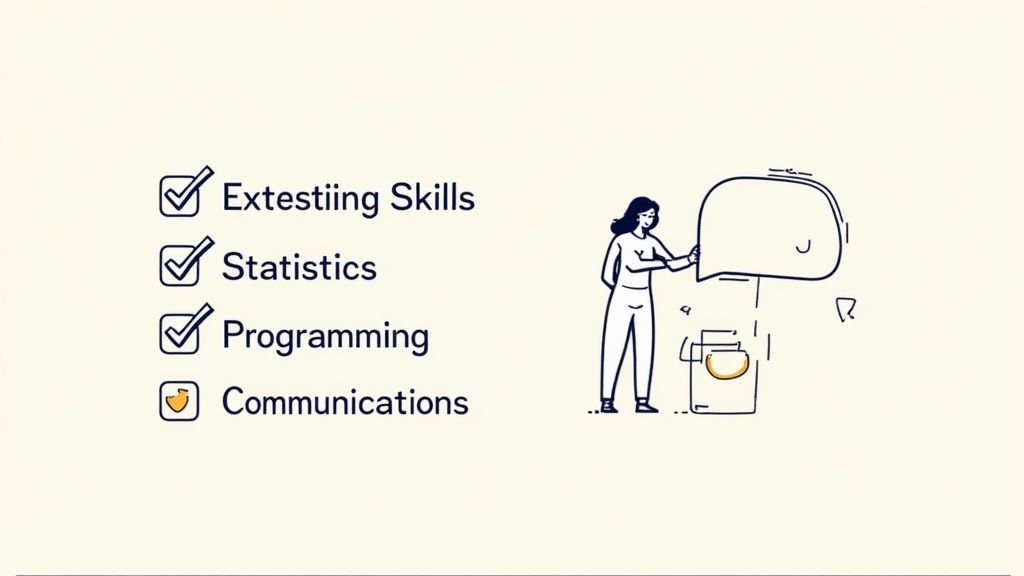
Having the right technical skills is your foundation, but your resume and portfolio are what actually get you in the door. Think of them as your personal marketing campaign.
A hiring manager for a pro team might sift through hundreds of applications for just one opening. You have to stand out, and fast. Your resume is the quick summary of your wins, while your portfolio is the hard proof. Together, they tell a powerful story about your ability to solve real problems with data.
Turning Projects Into Powerful Resume Bullets
A classic mistake is just listing your job duties. Let's be honest, teams aren't hiring you for what you did, they're hiring you for what you achieved. Every single bullet point on your resume needs to highlight an accomplishment and, whenever possible, measure its impact.
So, instead of a snooze-worthy line like, "Analyzed player performance data," reframe it to show the result. Something like this: "Developed a regression model to predict player shot efficiency, which identified 3 undervalued trade targets with 15% higher scoring potential than team averages." See the difference? One is a task; the other is a home run.
Here’s a simple formula to get you there:
- Action Verb: Kick things off with a strong verb like "developed," "engineered," or "optimized."
- Project/Task: Briefly explain what you built or analyzed.
- Impact/Result: Hit them with the outcome. Use metrics, numbers, and percentages to show your value.
Even if you're just starting out, apply this same logic to your personal projects. Quantify what your analysis uncovered or what your model proved.
Building a Portfolio That Gets You Noticed
Your portfolio is where you really separate yourself from the pack. A degree or a list of skills on a resume is one thing, but a portfolio full of tangible projects shows you can actually do the work. This is especially true if you're trying to break into the industry without direct experience.
The goal here is to show off your technical chops, your problem-solving process, and your raw passion for the sport. It proves you're not just another fan; you're an analyst who takes initiative. For a great gut check on what skills teams are hunting for, look at postings like this Basketball Analytics Intern position to see what's in demand right now.
Remember, your portfolio doesn't need dozens of projects. Two or three high-quality, deep-dive analyses are far more impressive than ten shallow ones.
Your portfolio is your single best tool for proving your value. It’s tangible evidence that you can apply your technical skills to answer interesting questions and generate insights that a team could actually use.
Portfolio Project Ideas to Get You Started
The key is to pick projects that genuinely fire you up. Your passion will shine through in the quality of your work. Luckily, there's a mountain of public sports data just waiting for you to dig in.
Here are a few ideas to get the wheels turning:
- Player Performance Analysis: Use play-by-play data to evaluate a player's true impact beyond the basic box score. You could analyze a basketball player's performance in clutch situations or a soccer player's effectiveness in different defensive schemes.
- Build a Predictive Model: Take a swing at predicting game outcomes, a player's future performance, or even the likelihood of an injury. This is a fantastic way to showcase your machine learning skills. Why not try building a model to predict the next World Cup or Super Bowl winner?
- Create a Compelling Visualization: Use a tool like Tableau to build an interactive dashboard. You could create something that lets a user explore historical draft data or compare player stats across different eras. This highlights your ability to communicate complex information in a clear, compelling way.
When you're ready to see what teams are looking for in real-time, browse the latest sports analytics jobs on www.sportsjobs.online. It’s a great way to get inspired and align your personal projects with what the industry actually needs.
How AI Is Shaping Modern Sports Analytics Roles
Let's be clear, Artificial Intelligence isn't some futuristic fantasy for sports teams anymore. It's here, and it's fundamentally changing what it means to be a sports analyst. The jobs popping up today are getting way more specialized, demanding a real, practical understanding of how AI and machine learning can solve tough problems, both on and off the field.
Teams are now desperate for analysts who can build models that predict what's going to happen, from a player's injury risk to how a specific in-game strategy will play out. If you can show you understand how to apply AI, you're positioning yourself as a problem-solver, not just a number-cruncher. If you want to see what these roles look like in practice, find your next opportunity at www.sportsjobs.online.
The Real-World Impact of AI in Sports
The applications we're seeing aren't just theoretical; they're incredibly practical and are already changing how teams operate.
- Smarter Player Tracking: AI-powered cameras now follow every single player in real-time. The tech can analyze a player's posture, acceleration, and even fatigue levels, giving analysts a dataset richer than anything we've had before.
- Proactive Injury Prediction: By feeding machine learning models biometric data from wearables, historical injury reports, and game workloads, teams are getting much better at flagging players who are at high risk for injury. This lets them tweak training or rest schedules to keep their stars healthy and on the court.
- Deeper Tactical Analysis: AI can chew through thousands of hours of game footage to spot an opponent's hidden habits or find the most effective play calls against a certain defense. This gives coaches hard, data-driven evidence to back up their gut feelings.
If you’re ready to jump into a role that merges these exciting technologies with business goals, you might find positions like this Performance Marketing Lead for Media Products interesting, as it shows how analytics directly fuels fan engagement and revenue.
AI’s role is to find the patterns that the human eye might miss. It’s about building systems that can process massive amounts of information and deliver a clear, actionable insight that gives a team a competitive advantage.
This graphic really paints a picture of the career path and growth you can expect in sports analytics.
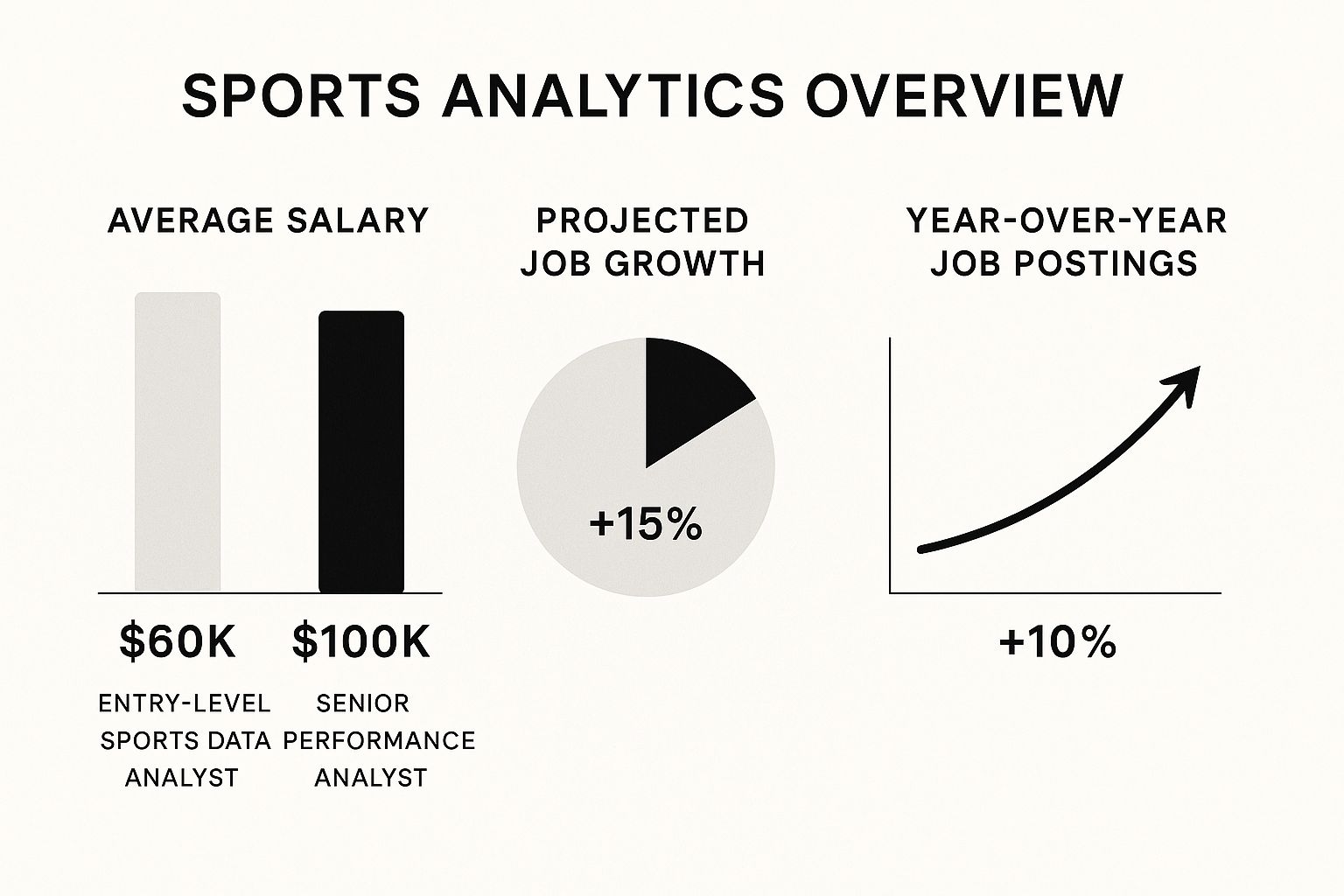
The data doesn't lie. It highlights a strong, ongoing demand for analytics talent across the sports industry, along with a significant salary bump with more experience.
The AI and Machine Learning Skills in Demand
To actually land one of these modern sports analytics jobs, you need the right tools on your toolbelt. Just saying you're "interested in AI" won't cut it. You have to prove you can work with the concepts and platforms that make it all happen.
And the opportunity is massive. The sports analytics market, valued at around USD 5.43 billion in 2025, is expected to explode to USD 29.36 billion by 2034, growing at a compound annual growth rate (CAGR) of about 20.6%. You can read the full research about these market trends to see just how big this wave is.
To get a feel for how these techniques are being used in the real world, let's break down some common applications.
Applying AI and Machine Learning in Sports
| AI/ML Technique | Sports Application | Example Problem Solved |
|---|---|---|
| Computer Vision | Analyzing video footage to track player movements and tactics. | Automatically identifying a team's offensive formations from game film. |
| Natural Language Processing (NLP) | Sifting through unstructured text like scouting reports or news articles. | Gauging public sentiment around a player trade by analyzing social media. |
| Reinforcement Learning | Simulating game scenarios to find optimal strategies. | Developing a model that suggests the best play to call on 4th and 1. |
| Predictive Modeling | Forecasting future events based on historical data. | Building a model to predict a player's likelihood of injury in the next month. |
As you can see, these aren't just academic exercises. They solve tangible problems that can make or break a season. Building expertise in these areas will make you a much more attractive candidate.
As you start your job hunt, make sure to check specialized boards like www.sportsjobs.online, where you can find roles that specifically list these advanced AI skills. Focusing your learning here is the smartest way to build a career in sports analytics that lasts.
Networking and Finding Open Positions
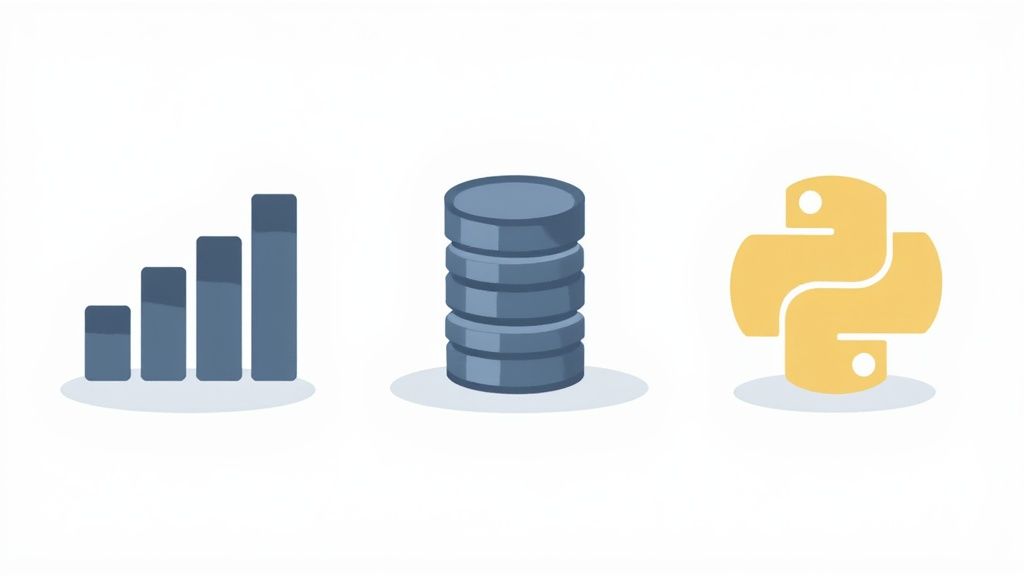
In the sports world, who you know really matters. That’s as true in the front office as it is on the court. While a killer portfolio and sharp technical skills are your ticket to the game, your network is often what gets your resume moved to the top of the pile.
The sports industry is a notoriously tight-knit community. You'd be surprised how many sports analytics jobs are filled through referrals or a quiet tip-off before they ever hit a public job board.
Building that network isn’t about being pushy or transactional. It's about genuine professional relationships with people who share your passion. You have to engage, offer value when you can, and show you’re serious about contributing to the field.
Tapping Into Digital Networks
You don’t have to be in the same room anymore to start making the right connections. Platforms like LinkedIn and Twitter are absolute goldmines for anyone trying to break into sports analytics.
- LinkedIn: Think of this as your professional home base. Follow teams, analytics companies, and the key people in the industry. But don't just "like" their posts, leave a thoughtful comment that adds to the conversation. A smart take can get you noticed.
- Twitter (X): The sports analytics community is incredibly active on Twitter. Analysts share their latest projects, debate new trends, and even post job openings. Following and interacting with these experts is a fantastic way to learn and build your own presence.
When you reach out to connect, make it personal. A generic request is easy to ignore. Instead, mention a specific project they worked on or an article they wrote that you genuinely found interesting. It shows you’ve done your homework.
The real goal of online networking is to go from being a random name to a familiar one. Consistent, intelligent engagement builds your reputation over time. It’s not about asking for a job on day one; it's about establishing yourself as a knowledgeable and passionate member of the community.
Where to Find Open Sports Analytics Jobs
Knowing where to look is half the battle. Sure, a lucky few might get a direct message about a new opening, but most of us need to be actively searching in the right places. Don't waste all your energy on massive job sites where your application can easily get buried.
For niche roles, you need niche resources. A fantastic starting point is a dedicated job board like www.sportsjobs.online, which is built specifically for this industry. You’ll find everything from internships to senior data scientist roles all in one place.
Beyond specialized boards, keep these spots on your radar:
- Team Websites: Nearly every pro team has a "Careers" page. Check them religiously. Teams often post openings here before anywhere else.
- League Websites: The NBA, NFL, MLB, and other major leagues have their own job portals with listings from their central offices and member teams.
- Sports Tech Companies: Don't forget the companies building the tools. Firms like Second Spectrum, Hawk-Eye, and the analytics divisions of major broadcasters are always hunting for talent.
The Power of Conferences and Meetups
As great as digital networking is, nothing beats face-to-face interaction. Sports analytics conferences are where you'll find the highest concentration of professionals in the field. Big events like the MIT Sloan Sports Analytics Conference are legendary, but smaller, regional events and local meetups can be just as valuable, and sometimes less intimidating.
When you go, have a game plan. Aim for a handful of quality conversations rather than just swapping business cards with everyone in the room. Ask people about their work, what challenges they're tackling, and what they’re excited about. That’s how you make a real, memorable connection.
A perfect example of a role you might find through networking or a specialized site is something like a Business Data Strategy Analyst. These hybrid roles, which blend analytics with business goals, often don't show up on generic job boards.
Ultimately, your job search needs a two-pronged attack. You should dedicate time to actively searching for open sports analytics jobs on platforms like www.sportsjobs.online, but you also need to be building your network at the same time. Your portfolio proves you can do the work; your network makes sure the right people see it.
Nailing the Interview and Landing Your Offer
So, you’ve hustled. Your portfolio is sharp, your networking paid off, and now you’ve landed the interview. This is it. This is your shot to prove you're the person who can give a team a real analytical edge.
Get ready, because sports analytics interviews are a different beast entirely. They’re a unique mix of a technical grilling, a test of your strategic mind, and a serious passion check. You have to prove you can handle the data, but just as importantly, you have to show you understand the soul of the game.
What to Expect in the Interview Process
The interview process for sports analytics jobs isn't a single conversation; it's a multi-stage gauntlet designed to test your skills from every possible angle. It almost always kicks off with a screening call to make sure your background and interest are a match. But things get technical, fast.
You can, and should, expect a take-home assignment. This is your first real test. A team might hand you a dataset and ask you to analyze a specific in-game scenario, evaluate a player, or build a simple predictive model. They want to see how you think, how you structure your code, and, crucially, how you communicate your findings.
The take-home assignment isn't just about getting the "right" answer. It's about showing your thought process. Clearly document your code, explain your assumptions, and create clean, insightful visualizations. Your ability to communicate your analysis is just as important as the analysis itself.
Nail the take-home, and you'll move on to a series of live interviews. This usually means a technical deep-dive with the analytics team and then a "culture fit" interview with a department head or even a front-office executive.
Answering Case Study and Behavioral Questions
During that technical interview, get ready for case studies. An interviewer might throw a real-world scenario at you, like, "We're considering trading for Player X. Walk me through how you would use data to evaluate this decision."
This is your moment. There’s no single correct answer here. They just want to see how you attack the problem.
- Clarify the Goal: Don't just dive in. Start by asking smart, clarifying questions. What position does he play? What are our team's biggest needs right now? What's our budget look like?
- Outline Your Method: Explain the data you'd want to pull (player tracking data, advanced box score stats, contract info) and the techniques you'd use (comparing him to similar players, projecting future performance, etc.).
- Communicate Your Thinking: This is key, talk through your reasoning out loud. Explain why you're picking certain metrics over others and what potential blind spots or pitfalls you'd be looking out for.
Beyond the nitty-gritty technical side, be ready to talk about your passion. Why this team? Why this specific sport? Come prepared with genuine questions that prove you’ve done your homework on the team’s recent performance, their front office philosophy, or even recent jobs they’ve posted on sites like www.sportsjobs.online.
This shows you aren't just looking for any job; you're looking for this one.
Common Questions I Hear About Sports Analytics Jobs
As you start getting serious about landing a job in sports analytics, a few key questions always seem to surface. I've been there. Getting straight answers can help you channel your energy in the right places and set realistic expectations.
Let's break down some of the most common questions I get asked.
Do I Really Need a “Sports Analytics” Degree?
Honestly, no. While you might see more dedicated "sports analytics" degrees popping up, they are absolutely not a deal-breaker for most roles. What hiring managers really care about are your tangible, technical skills.
Most pros I know in the field have backgrounds in quantitative fields, think statistics, computer science, data science, or math. The degree is the foundation, but what truly gets you in the door is proving you can handle Python or R, are comfortable with SQL, and have a portfolio that shows you can do the work. A specialized degree is a nice bonus, but your practical skills are the real ticket to an interview.
So, What's the Real Salary I Can Expect?
This is a big one, and the answer is... it depends. Salaries in sports analytics can swing pretty widely based on the league, the team, and where you're located. For an entry-level analyst just starting out, you’re likely looking at a range of $55,000 to $75,000.
But that's just the starting line. The real earning potential explodes as you build experience and develop specialized skills. Analysts who are wizards with machine learning or have a documented history of building models that actually make an impact can pull in salaries well into the six-figure range. As you prove your value, your paycheck will reflect it. For a live look at the market, I always recommend checking out the current listings on www.sportsjobs.online.
Your domain knowledge is what turns data into strategy. It’s the critical link between a spreadsheet and a smarter decision on the field, which is why teams value it so highly.
How Important Is It to Actually Know the Sport?
It’s everything. Let me be clear, this is absolutely critical. Your technical chops get you in the door, but a deep, nuanced understanding of the sport is what makes you truly effective.
You have to be the one who gives context to the numbers. Anyone can pull stats, but knowing why a manager made a specific substitution or how a particular defensive scheme affects a player's performance is what separates a decent analyst from a great one. This is the domain expertise that helps you ask the right questions and deliver insights that a coach or GM can actually use to win more games. It’s a non-negotiable.
Ready to turn your passion into a career? Sportsjobs Online is your go-to resource for finding the latest openings in the industry. Browse current sports analytics jobs and take the next step.
Hundreds of jobs are waiting for you!
Subscribe to membership and unlock all jobs
Sports Analytics
We scan all major sports and leagues
Updated Daily
New jobs are added every day as companies post them
Refined Search
Use filters like skill, location, etc to narrow results
Alerts
You can get daily alerts in your email for a specific search
Access to job postings from top teams and companies
Daily updates and notifications based on your preferences
🎯 Over 90% of customers chose to renew their subscriptions after the initial sign-up
Monthly
$6.99
per month
✓ Flexible monthly billing
✓ Unlimited access to all jobs
✓ Advanced filtering tools
✓ Daily job alerts
✓ Exclusive discount codes
✓ Cancel anytime
BEST VALUE
Yearly
$39
per year • Only $3.25/mo
✓ Save 50% vs monthly
✓ Unlimited access to all jobs
✓ Advanced filtering tools
✓ Daily job alerts
✓ Exclusive discount codes
✓ Cancel anytime
Lifetime
$59
one-time • forever
✓ Pay once, access forever
✓ Unlimited access to all jobs
✓ Advanced filtering tools
✓ Daily job alerts
✓ Exclusive discount codes
✓ Best long-term value